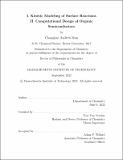I. Kinetic Modeling of Surface Reactions II. Computational Design of Organic Semiconductors
Author(s)
Kim, Changhae Andrew
DownloadThesis PDF (45.48Mb)
Advisor
Van Voorhis, Troy
Terms of use
Metadata
Show full item recordAbstract
In Part I of this thesis, we propose moment closure methods to simulate the chemical kinetics of surface reactions. For systems with static disorder in the rate constants and short-range correlation in the densities of reactants, we propose the half heterogeneous pair approximation (HHPA). Combining the intuitions of the mean-field steady state (MFSS) method and the pair approximation (PA), we consider representative pairs of sites in a self-consistent bath of the average pairwise correlation. Preaveraging over the static disorder in one site of each pair makes HHPA efficient enough to simulate systems of several species and calibrate rate constants. For systems with long-range dynamic correlation, we propose the use of machine learning (ML) to construct system-specific moment closures. Using the lattice Lotka-Volterra model (LLVM) as a model system, we trained feedforward neural networks (FFNNs) on kinetic Monte Carlo (KMC) results at select values of rate constants and initial conditions. The ML moment closure (MLMC) gave drastic improvements in the simulated dynamics and descriptions of the dynamical regimes throughout the parameter space.
In Part II of this thesis, we propose new design principles to enhance the efficiencies of organic light-emitting diodes (OLEDs). In particular, we are interested in thermally activated delayed fluorescence (TADF) and triplet-triplet annihilation (TTA), which convert the nonemissive triplet excitons into emissive singlet excitons. First, we introduce a simple four-state model of TADF. The model predicts that it is possible to realize adiabatic singlet (S₁) and triplet (T₁) states with fast T₁ → S₁ intersystem crossing (ISC) and S₁ → S₀ radiative decay. Using molecular dynamics (MD) and the time-dependent density functional theory (TDDFT), we consider conformational variation as a means to sample the parameter space, and then we examine the potential of direct optimization to maximize the TADF rate. Second, we investigate the role of ISC in enhancing the efficiencies of TTA upconverters. We present computational evidence that the limit-breaking TTA efficiencies of certain annihilators might be attributed to the T₂ → S₁ ISC. Furthermore, we propose strategies to enhance this ISC and provide experimental support of enhanced efficiencies.
Date issued
2022-09Department
Massachusetts Institute of Technology. Department of ChemistryPublisher
Massachusetts Institute of Technology